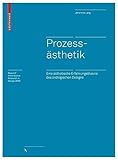Prozessästhetik : Eine ästhetische Erfahrungstheorie des ökologischen Designs / Johannes Lang.
Material type: TextSeries: Board of International Research in DesignPublisher: Basel : Birkhäuser, [2015]Copyright date: ©2015Description: 1 online resource (176 p.)Content type:
TextSeries: Board of International Research in DesignPublisher: Basel : Birkhäuser, [2015]Copyright date: ©2015Description: 1 online resource (176 p.)Content type: - 9783035603262
- 9783035603156
- 9783035603118
- online - DeGruyter
| Item type | Current library | Call number | URL | Status | Notes | Barcode | |
|---|---|---|---|---|---|---|---|
 eBook
eBook
|
Biblioteca "Angelicum" Pont. Univ. S.Tommaso d'Aquino Nuvola online | online - DeGruyter (Browse shelf(Opens below)) | Online access | Not for loan (Accesso limitato) | Accesso per gli utenti autorizzati / Access for authorized users | (dgr)9783035603118 |
Browsing Biblioteca "Angelicum" Pont. Univ. S.Tommaso d'Aquino shelves, Shelving location: Nuvola online Close shelf browser (Hides shelf browser)

|

|

|

|

|

|

|
||
| online - DeGruyter Une petite maison / | online - DeGruyter Le Corbusier – Les Villas La Roche-Jeanneret / The Villas La Roche-Jeanneret / | online - DeGruyter Le Corbusier. Les Quartiers Modernes Frugès / The Quartiers Modernes Frugès / | online - DeGruyter Prozessästhetik : Eine ästhetische Erfahrungstheorie des ökologischen Designs / | online - DeGruyter Le Corbusier. Le Couvent Sainte Marie de La Tourette / The Monastery of Sainte Marie de La Tourette / | online - DeGruyter Ahmet Oran : Malerei und Arbeiten auf Papier / Paintings and Works on Paper / | online - DeGruyter Keramische Bausysteme : in Architektur und Innenarchitektur / |
Frontmatter -- Inhaltsverzeichnis -- Vorwort BIRD -- Vorwort -- Einleitung -- Die Materialgeschichte -- Die Produktionsgeschichte -- Die Gebrauchsgeschichte -- Ästhetische Reflexionen -- Anhang -- Backmatter
restricted access online access with authorization star
http://purl.org/coar/access_right/c_16ec
Johannes Lang beobachtet und analysiert die Entwicklung des ökologischen Designs unter erfahrungsästhetischen und bewusstseinsgeschichtlichen Gesichtspunkten. Es geht ihm um das Aufdecken und Erkennbar-Machen neuer Produkterfahrungen, die vor dem Hintergrund ökologischer Denk- und Designansätze entstehen – nicht um die Operationalisierung ökologischer Prinzipien für die Praxis. Untersucht wird die ästhetische Gestaltung von Produkten im Kontext des wachsenden Bewusstseins für ökologische Zusammenhänge, in Abgrenzung zum Begriff der Nachhaltigkeit, der nicht nur ökologische, sondern auch soziale Aspekte einschließt. Das Buch zeigt, dass die Berücksichtigung ökologischer Gesichtspunkte im Design nicht nur zu neuen Technologien führt, sondern auch zu einer neuen Ästhetik, die hier als Prozessästhetik charakterisiert wird. Dabei werden weder die faktische noch die ästhetische Seite des Produktes isoliert aufgefasst, sondern in ein Verhältnis gesetzt, das weder deterministisch im Sinne eines «form follows function» noch willkürlich im Sinne einer «Produktsprache» ist, sondern vielmehr reflexiv. Anhand zahlreicher Beispiele führt der Autor die für ökologische Zusammenhänge relevanten Prozesse der Materialgeschichte, der Produktionsgeschichte und der Gebrauchsgeschichte vor Augen. Der Begriff der «Prozessästhetik» wird so greifbar: er umfasst jene sinnlichen Reflexionen, in denen die natürlichen Prozesse der Produktgeschichte zu einem Teil der Produkterfahrung werden.
Johannes Lang observes and analyzes the development of ecological design from the point of view of the aesthetics of experience and the history of consciousness. He strives to discover and identify new product experiences that emerge against the background of ecological approaches to thinking and design – not to address the operationalization of ecological principles for praxis. He investigates the aesthetics of product design in the context of the growing awareness of ecological realities – in contradistinction to sustainability, which encompasses not just ecological, but social aspects as well.This book shows how the introduction of ecological concerns into design not only leads to new technologies, but also to a new aesthetic, characterized here as “process aesthetics.” The practical and aesthetic aspects of a product are considered not in isolation but instead in their interrelationship – neither deterministically in the sense of “form follows function,” nor arbitrarily in the sense of a “product language,” but instead reflexively. Through numerous examples, the author discusses processes that are observable in the history of materials, of production, and of practical utilization as they are relevant to ecological relationships. In the process, the term “process aesthetics” becomes tangible: it encompasses those sensuous reflections through which the natural processes of product history become a part product experience.
Mode of access: Internet via World Wide Web.
In German.
Description based on online resource; title from PDF title page (publisher's Web site, viewed 23. Jun 2020)


